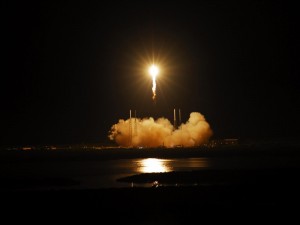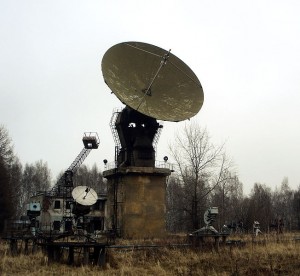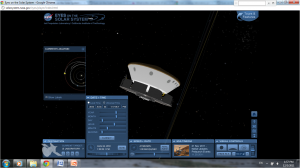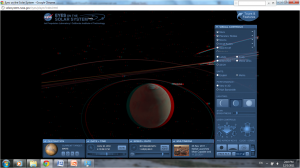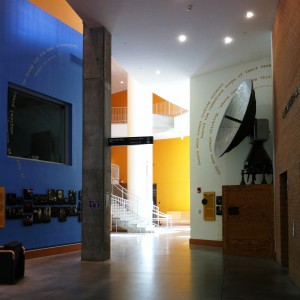
Rad Lab and Building 20 Exhibit, Stata Center, MIT
In addition to trying to wrap up the typical end-of-the-semester tasks last week, I also made a quick trip to MIT (Cambridge, MA). I had a few hours to myself on either side of my meetings and I put those hours to good use by walking as much of campus as possible. Needless to say, MIT sits at the intersection of my primary research foci, architecture and science. Perhaps also needless to say, my first stop was the Stata Center, the most controversial building on campus (still, even though it opened in 2004).
Early dissent over the Stata Center had little to do with the design itself and a lot to do with emotional and intellectual attachment to the building it was slated to replace, Building 20. For the purposes of this site, the most notable thing about Building 20 was the fact that it once housed the Radiation Laboratory funded by the National Defense Research Committee (NDRC). Although MIT’s involvement with military research was always seen as problematic by some (and those sentiments would increase during the Vietnam era), during World War II, Rad Lab became the control center for a global research network centered on applied microwave physics.[1] Most of the radar and microwave communication technologies developed during the war came out of the Rad Lab; the British military developed the rest.
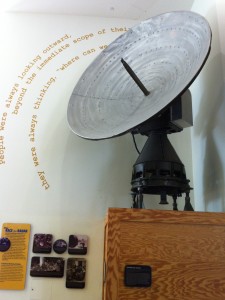
Rad Lab Exhibit, Stata Center, MIT
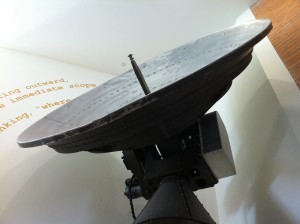
SCR-615B Radar Antenna, Stata Center, MIT

Signage, Building 20 Exhibit, Stata Center, MIT
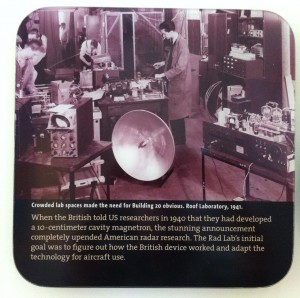
Signage, Building 20 Exhibit, Stata Center, MIT
The photos above show the homage to Rad Lab in one of the hallways of the Stata Center. The radar antenna stands on top of a wooden crate that holds a Building 20 time capsule. Kudos to the person who chose this particular antenna as representative of MIT’s research. As the accompanying signage explains, the SCR-615 radar system was “not one of the best” (possibly explaining why there was a spare dish sitting around the MIT Museum). You know you’ve got confidence when your celebratory display highlights not just your research successes, but your research disappointments.

Sign attached to time capsule, Stata Center, MIT

Julian Schwinger has great style, makes war look like an intellectual exercise. Building 20 Exhibit, Stata Center, MIT
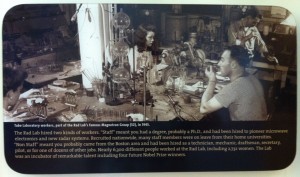
Non Staff? Building 20 Exhibit, Stata Center, MIT

Mixed message, Building 20 Exhibit, Stata Center, MIT
With the end of WWII came the end of Rad Lab, but not Building 20. Research in microwave physics was absorbed into the Research Laboratory of Electronics (RLE), housed in the A wing of the building. The Laboratory for Nuclear Science (LNS) took up another good chunk of the space. The military maintained a presence in Building 20 in the form of ROTC headquarters as well as a few U.S. Navy offices. More famously, the building also became home to MIT’s linguistics department. One wonders how different Noam Chomsky’s ideas about the military and U.S. foreign policy would have been had the department been housed in Kresge Auditorium (probably not THAT much different, but still).
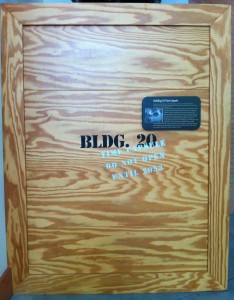
Time Capsule, Stata Center, MIT
Building 20 is no more, of course. In its place stands the Stata Center, a 3-dimensional wonderland of space designed by Gehry Partners LLP.[2] The controversy comes from the multitude of problems reported by users of the building. MIT eventually sued (and then settled with) Gehry.
I have much to say about the Stata Center, so feel free to contact me if you’re interested in my analysis. My photos of the building are available on flickr, as are my photos of other parts of the MIT campus.
If you’d like to read a warm and fuzzy article about Building 20 and its role in MIT’s campus culture, see “A Last, Loving Look at an MIT Landmark—Building 20,” RLE undercurrents Vol. 9, No. 2 (Fall 1997). [download .pdf].
————–
[1] If you’re interested in campus tensions during the Vietnam War (MIT was the largest defense contractor in the U.S. at the time), read Stuart Leslie, “‘Time of Troubles’ for the Special Laboratories,” in Becoming MIT: Moments of Decision, ed. David Kaiser (Cambridge: MIT Press, 2010), 123-43.
[2] More confidence: Frank Gehry’s firm doesn’t even have a real website. Gehry Partners LLP has zero information about the firm and its projects. Gehry and partners don’t really need to invest time and money in their own advertising—trade and academic publications do all their publicity for them.
